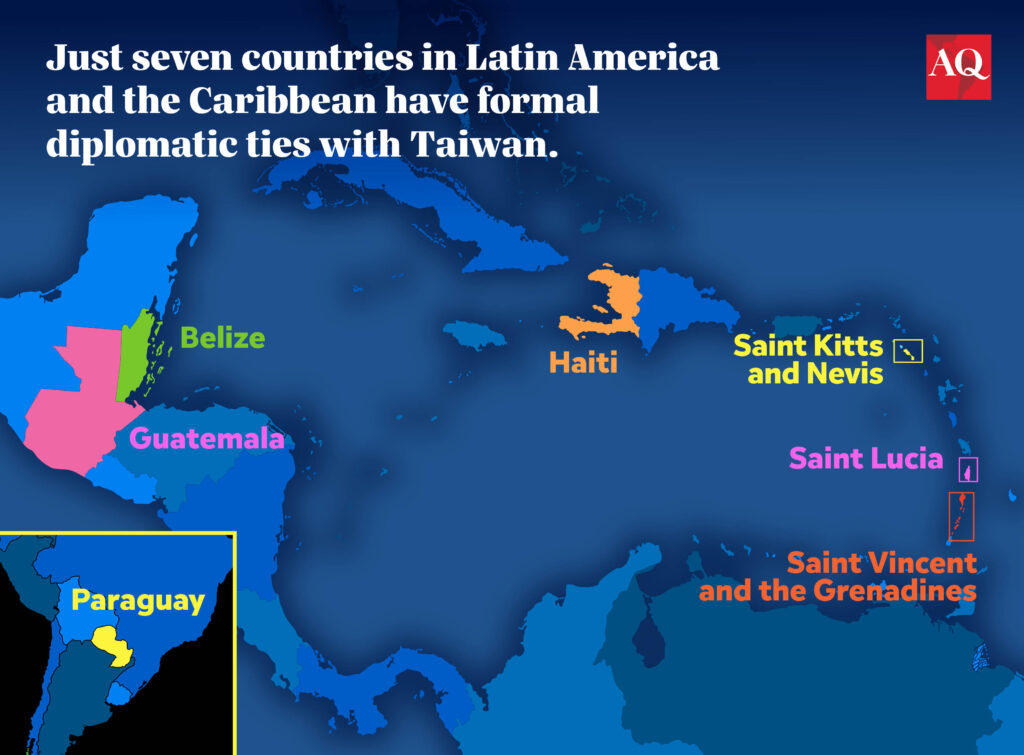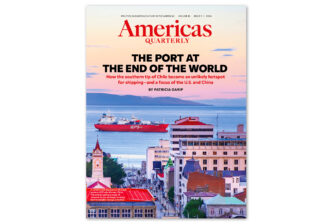For most Latin Americans, the region is beset by more acute security challenges than the fate of the One China policy. These include a surge in criminality affecting political stability as well as homegrown and quixotic irredentism. Anemic economic growth—The Economist Intelligence Unit forecast that the region will grow by a mere 1.7% this year—and a high level of corruption also keep voters’ minds squarely looking inward. However, there are reasons for cautious optimism, too.
The war in Ukraine and the rising tensions in the Middle East dominate the news, so the situation in the Taiwan Strait barely registers for Latin Americans. Moreover, the fear of military conflict between nations is at the bottom of the pack of concerns for Latin Americans, with an average of 2% in the top six economies saying it’s a worry, according to a March survey by IPSOS.
This complacency is understandable, given that the region is far away from global hotspots. Furthermore, Latin America has not had an inter-state war since 1995. Apart from a bout of inflation caused by the Russian invasion of Ukraine in 2022, global conflicts have not yet seriously harmed Latin American economies, as the region is largely isolated from supply chains affected by conflict. The same cannot be said of China and Taiwan, both of which are critical for the region’s economic well-being.
Blind spots
China’s rise as an economic superpower has transformed the world, including Latin America. The Asian giant is the main export market for most countries in Latin America, snapping up the region’s commodity exports from soybeans to copper. Chinese firms are also major investors in the region and important suppliers of high-end consumer goods like cars and cell phones. Less well-known is China’s leverage over many of Latin America’s economies due to the fact that it dominates the refining of the most critical minerals.
Taiwan, on the other hand, has a small diplomatic and economic footprint in the region. During the Cold War, the Republic of China—the island’s formal name—used to enjoy broad diplomatic recognition in the region as the legitimate representative of China, but gradually, countries switched their recognition to the People’s Republic of China (mainland China). After Honduras switched recognition to mainland China in 2023, only Belize, Guatemala, Haiti, Paraguay, and a handful of Caribbean islands still recognize Taiwan.

Although direct trade with Taiwan is small, the region is indirectly dependent on the island. Taiwan is, by far, the world’s main producer of semiconductors, especially for leading-edge chips. If for whatever reason there is no longer a secure supply of semiconductors from Taiwan, the global economy would grind to a halt. The economic consequences for Latin America, which has limited semiconductor production, would be devastating.
Set your alarms
Tensions between China and the U.S. are fueling a process of economic fragmentation, with these superpowers increasingly willing to trade off efficiency for resilience in their supply chains. The risk of “Cold War II” is rising, and the economic costs could be enormous. The IMF estimates that if the world’s economy splits into two blocs, foregone global economic growth could be between 2.5% and a whopping 7%. Although some countries in Latin America may benefit from the U.S. nearshoring production, the region as a whole is unlikely to benefit, especially in the long run. This downbeat scenario assumes that the U.S. and China do not go to war.
Tensions in the Taiwan Strait are likely to grow in the coming years. Although war is unlikely, given the extreme costs that it would entail for the Chinese and the global economy, the risk is big enough that it should serve as a wake-up call for Latin America to start considering contingency plans. The task is daunting: A war would create an economic crisis that would be worse and longer-lasting than the COVID-19 pandemic, as it would radically reshape global supply chains and geopolitics (assuming nuclear Armageddon is avoided).
According to some calculations, a war in Taiwan could cost the world economy 10% of its GDP, which is almost double the impact of the pandemic. Their estimates show that Mexico’s economy could contract by 13% and Brazil’s by 5.9%, largely explained by the loss of access to semiconductors. Estimates for countries that rely heavily on commodity demand, like Chile and Peru, are not included, but it is likely that they could see even more dramatic recessions, as the main destination for their critical mineral exports is China.
What now?
Although Latin America is unlikely to face any actual military conflict from a war in Taiwan, the region is ill-prepared to confront the potential economic consequences. Even advanced economies, like the U.S. and the European Union, are struggling to ramp up production of semiconductors and other key inputs to increase self-sufficiency. The U.S. has been forced to concede that total deleveraging is not possible.
If Latin America plays its cards right and acts fast, it can at least mitigate the potential impact of a war given its dominance in the production of critical minerals like copper and lithium. Governments in the region need to encourage the exploration and development of rare earth metals (currently dominated by China), which are critical for semiconductor production. Governments also need to leverage these natural endowments and the region’s relative geopolitical isolation to encourage investments to boost refining capacities, which would help the global economy diversify its sources of refined critical minerals away from China.
So far, the U.S. and its allies lag behind the Chinese, who are leading the way in boosting Latin America’s industrial capacity in these sectors. Chinese firms have announced investments in facilities in Chile to refine lithium. Russian and Chinese firms have signed agreements to develop Bolivia’s untapped lithium resources. Chinese electronic vehicle (EV) giant BYD is also setting up its first EV factory outside of Asia in Brazil and talks between BYD and a lithium producer in Brazil, Sigma Lithium, are ongoing to secure supply. If the West wants to compete, they will need to move faster and more boldly than they are currently.
The other challenge facing the region’s governments will be diplomatic. During World War II, most Latin American countries quickly backed the U.S. after the Pearl Harbor attack. It is not clear if the region would so eagerly back the U.S. and its allies this time, especially countries like Venezuela, Nicaragua and Cuba. The region’s lukewarm reaction to the war in Ukraine, its economic dependence on China, and anti-U.S. sentiment raise serious doubts. Although war is unlikely, and Latin Americans are understandably preoccupied with more pressing issues, both political elites and voters need to start acknowledging that they may have very tough choices to make sooner than they would care to admit.









